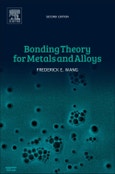Bonding Theory for Metals and Alloys, 2e builds on the success of the first edition by introducing new experimental data to each chapter that support the breakthrough "Covalon" Conduction Theory developed by Dr. Wang. Through the recognition of the covalent bond in coexistence with the 'free' electron band, the book describes and demonstrates how the many experimental observations on metals and alloys can all be reconciled. Subsequently, it shows how the individual view of metals and alloys by physicists, chemists and metallurgists can be unified.
This book covers such phenomena as the Miscibility Gap between two liquid metals, phase equilibrium, superconductivity, superplasticity, liquid metal embrittlement, and corrosion. The author also introduces a new theory based on 'Covalon' conduction, which forms the basis for a new approach to the theory of superconductivity. Bonding Theory for Metals and Alloys, 2e is of interest to physical and theoretical chemists alongside engineers working in research and industry, as well as materials scientists, physicists, and students at the upper undergraduate and graduate level in these fields.
Please Note: This is an On Demand product, delivery may take up to 11 working days after payment has been received.
Table of Contents
I. Miscibility Gap (MG) between Two Liquid Metals II. Phase Equilibrium Diagrams III. Phenomenon of Melting IV. Superconductivity V. NITINOL; A Metal-Alloy with Memory VI. Mechanical Properties VII. Summary of the Bonding Theory








